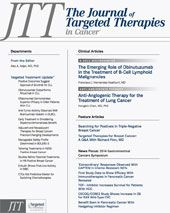Manageable Safety Profile Determined in BOLERO-3
Previously revealed efficacy data from the BOLERO-3 study indicated slowed tumor progression in patients with trastuzumab-resistant HER2+ breast cancer, and now everolimus, trastuzumab, and vinorelbine has demonstrated a manageable safety profile.
Guy Jerusalem, MD
Previously revealed efficacy data from the BOLERO-3 study indicated that adding everolimus, an mTOR inhibitor, slowed tumor progression in patients with trastuzumab-resistant HER2-positive advanced breast cancer, and now the combination of everolimus, trastuzumab and vinorelbine has demonstrated a manageable safety profile, according to an analysis of the international phase III study presented at the 2013 San Antonio Breast Cancer Symposium.
BOLERO-3 evaluated the efficacy and safety of adding everolimus (5 mg/day) to trastuzumab (2 mg/kg weekly), and vinorelbine (25 mg/m2), compared with placebo, trastuzumab, and vinorelbine in 569 women with trastuzumab- resistant HER2-positive advanced breast cancer previously treated with a taxane. As presented at the 2013 Annual Meeting of the American Society of Clinical Oncology, the primary efficacy endpoint, progression-free survival (PFS), was longer in the everolimus arm compared with the placebo arm (median: 7.0 months vs 5.78 months; HR = 0.78;P= .0067) at a median follow-up of 20 months.
Study drugs were continued until disease progression or unacceptable toxicity. Incidences of adverse events (AEs) were monitored continuously. Cardiac imaging was assessed at screening and every 12 weeks. The safety population included all patients who received at least one daily dose of study treatment and who had at least one valid post-baseline safety assessment.
Treatment in BOLERO-3 represented the second, third, or fourth line of chemotherapy for 84% of patients in the metastatic setting. One-fourth of the patients in each group had a treatment history that included the anti-HER2 agent lapatinib.
The median duration of exposure to study treatment was similar across the treatment groups, and ranged from 22.9 weeks for placebo to 25.1 weeks for trastuzumab in the experimental arm.
Guy Jerusalem, MD, head of Medical Oncology at the University of Liege in Belgium, presented the safety results at the symposium.
Class-effect AEs associated with mTOR inhibitors (eg, stomatitis, rash, noninfectious pneumonitis, hyperglycemia) occurred more frequently in the everolimus arm, and most were grade 1/2.
The incidences of serious AEs suspected to be treatment- related were 26.4% in the everolimus arm and 6.4% in the placebo arm. Grade 3 class-effect AEs in the everolimus arm each occurred in less than 15% of patients: (stomatitis, 13%; hyperglycemia, 4%).
“We added a targeted agent and we expect to add some toxicity, so we have somewhat more neutropenic fever and also stomatitis, which of course is a typical side effect associated with everolimus,” said Jerusalem. “Vinorelbine also produces stomatitis, so giving both together will give an even higher incidence of stomatitis.”
At 6% for all grades, the incidence of noninfectious pneumonitis was less than it was in other clinical trials of everolimus. “Noninfectious pneumonitis is generally reported to be 15% with everolimus, with a 3% incidence of grade 3 toxicity,” he said. “One possible explanation is the dose used in this study5 mg. But other factors may contribute. Corticosteroids are sometimes given as antiemetic treatments during cancer chemotherapy. There may also be an immunosuppressive effect of the chemotherapy added.”
Grade 4 noninfectious pneumonitis occurred in less than 1% of patients, and there were no grade 4 events of stomatitis or hyperglycemia, and no grade 3/4 events of rash, according to the abstract. There were 10 instances of a decrease in ejection fraction that caused treatment discontinuation in everolimus-treated patients and one in the placebo group.
The increased toxicity in the everolimus arm did not affect quality of life or performance status. The median time to deterioration in European Cooperative Oncology Group performance status was 32.66 months in the everolimus arm versus 21.55 months in the placebo arm, a nonsignificant difference.
As per protocol, patient-reported, health-related quality- of-life (HRQoL) data were a part of a separate analysis reported. This analysis showed no negative impact of everolimus on overall and functional HRQoL scores. There was no significant difference in the median time to definitive deterioration (TTD) of HRQoL between treatment arms, while the median TTD in global health status score was 8.3 months in the everolimus arm and 7.3 months in the placebo arm, a nonsignificant difference.
A subanalysis of the 166 Asian patients included in BOLERO-3 demonstrated a similar benefit to everolimus on PFS in Asian patients compared with the overall study population and a comparable manageable safety profile.

Powell Reviews Updated IO/TKI Data and AE Management in Endometrial Cancer
April 18th 2024During a Case-Based Roundtable® event, Matthew A. Powell, MD, discussed the case of a patient with advanced endometrial cancer treated with lenvatinib plus pembrolizumab who experienced grade 2 treatment-related hypertension.
Read More
Breast Cancer Leans into the Decade of Antibody-Drug Conjugates, Experts Discuss
September 25th 2020In season 1, episode 3 of Targeted Talks, the importance of precision medicine in breast cancer, and how that vitally differs in community oncology compared with academic settings, is the topic of discussion.
Listen
Savona Discusses First-Line JAK Inhibition for Patients With Myelofibrosis at Risk of Anemia
April 17th 2024During a Case-Based Roundtable® event, Michael Savona, MD, and participants discussed the case of a patient with myelofibrosis and moderate anemia receiving JAK inhibitor therapy.
Read More
Biomarker Testing Paves the Way for Better Targeted Therapies in NSCLC
April 16th 2024At a live virtual event, Edward S. Kim, MD, MBA, discussed the evolving landscape of biomarker testing before making treatment decisions for patients with early-stage non–small cell lung cancer (NSCLC).
Read More